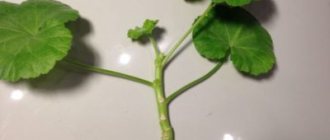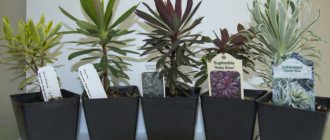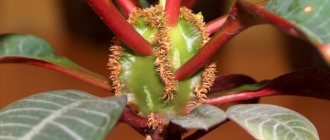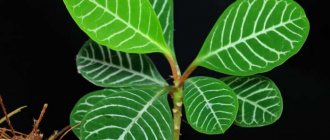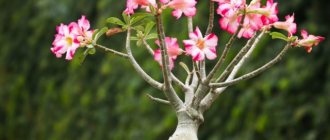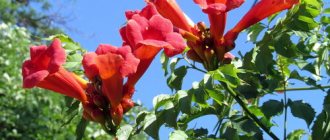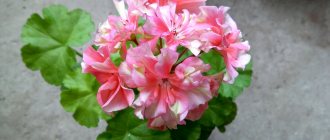Euphorbia (Euphorbia) is an annual or perennial plant of the Euphorbia family. In total there are about 2000 species, very diverse in shape, size, habitat, and growing conditions. A common characteristic of euphorbias is a white, viscous sap that resembles milk. A special feature of milkweed is that the juice in its stems and leaves is under pressure, so if the integrity of the plant is damaged, the juice comes out quickly and in large volumes.
Source: depositphotos.com
In the middle zone, the most common spurges are sungazer, cypress, vine, garden spurge, white-veined spurge, etc.
The chemical structure of milkweed is poorly understood, however, it has become widely used in folk and homeopathic medicine as an immunomodulatory, antiviral, antifungal, antibacterial, antiseptic, and antitumor agent. Used in alternative therapy for oncological, gynecological, gastroenterological, nephrological, neurological diseases, immunodeficiency conditions, and skin diseases.
The main medicinal raw materials are milkweed grass and roots; tinctures, decoctions, and juice are made from the plant.
Despite the popularity of milkweed in folk treatment, it is necessary to remember that it is extremely toxic. The main danger is the milky juice, which contains powerful toxins euphorbin and saponin, which have a locally irritating and cauterizing effect.
How does milkweed poisoning occur?
If it comes into contact with the skin and mucous membranes, a burn from milkweed juice occurs; if the juice or parts of the plant get inside, it causes poisoning. The following situations may pose a danger:
- replanting or pruning an ornamental house plant;
- working with weeds in the garden (some types of milkweed are classified as weeds);
- independent preparation of medicines from milkweed or use of homemade products;
- eating the leaves or stems of the plant;
- playing with plant parts for children.
Content Rules
White-veined milkweed does not require special care or special conditions. The main condition is to prevent waterlogging and drying out of the soil. Moderate watering is required. In winter, it is better to reduce it to a minimum, since the plant rests during this period. Also, this type of euphorbia does not tolerate direct sunlight. If you place a flower on the sunny side under direct rays of the sun, you will soon notice that the leaves begin to turn yellow and fall off one by one.
The flower is best planted in a wide pot. The capsule in which the seeds are located bursts when ripe and the seeds scatter. If a seed falls into the soil, it can take root there and soon another sprout of milkweed will appear. In the first years of life, spurge should be replanted once a year, and then less often.
The flower needs feeding. Ideal for feeding succulents. Feeding spurge three times a month is required in the summer, and once in the winter is enough.
If you organize suitable conditions, you will soon notice that the white-veined spurge is strengthening and producing more and more new leaves. The flower grows quite quickly and can reach a height of about half a meter.
Symptoms of poisoning and burns with milkweed
When accidentally or intentionally ingesting parts of the plant or juice, severe toxic gastroenteritis develops, the symptoms of which are:
- headache, dizziness;
- pain and burning along the esophagus;
- intense abdominal pain;
- nausea, vomiting, diarrhea;
- bloating.
Symptoms of poisoning appear 8-12 hours after eating milkweed. Beginning with a dyspeptic disorder, as the disease progresses it becomes general. Against the background of vomiting and diarrhea, dehydration develops, manifested by severe weakness, dry mouth, thirst, decreased blood pressure, increased heart rate, followed by a rare thread-like pulse.
When toxins are absorbed into the systemic bloodstream, toxic damage to the central nervous system occurs: convulsions, confusion, apathy, disorientation, increased body temperature, and in severe cases, coma may develop.
The plant poses a great danger to people suffering from allergic diseases, as it can cause severe reactions, including Quincke's edema. Its clinical manifestations are swelling of the soft tissues of the face, pharynx, difficulty breathing and swallowing. An allergic reaction to poisoning with the milky juice of milkweed can be lightning fast.
When milky juice gets on the skin, a violent local reaction develops. At the site of contact, the skin turns red, severe itching, burning, local swelling, and rashes appear.
If milkweed juice splashes into the eyes, a sharp burning pain appears, swelling of the eyelids, visual acuity decreases, active lacrimation occurs, the conjunctiva becomes inflamed (becomes hyperemic, swollen), pinpoint ulcerations may appear, and sometimes it becomes impossible to open the affected eye. Blindness may develop, and in severe cases, permanent blindness.
When juice gets on the oral mucosa, hyperemia, numbness and swelling of the lips and tongue, profuse salivation, burning and soreness in the throat occur.
Source: depositphotos.com
Ways to combat diseases and pests
There are few diseases of milkweed Mil, since the culture has a fairly high immunity to various pathologies. As a rule, the flower is affected by fungi that develop due to improper care of the crop (Figure 7).
Common houseplant diseases include:
- Gray rot: characteristic gray or brown spots appear on stems and leaves. After their detection, it is necessary to immediately treat them with fungicides. A similar method is used to combat stem rot, which affects the main stem of the crop from the top to the roots.
- Alternaria blight: a symptom of the pathology is also the formation of spots on the leaves, but they are usually small in size. Fungicides are also used to eliminate pathology.
- Bacteriosis: may appear if the leaves have been mechanically damaged. All affected parts must be removed, and the bush itself must be provided with more thorough care.
Figure 7. Disease symptoms begin to appear on leaf blades
Milk milkweed pests are more common. As a rule, the same insects are found on the flower as on other indoor plants. The most common of these are aphids, whiteflies and spider mites, although in some cases mealybugs may also appear in the soil. All these pests deprive the plant of nutrients, its leaves begin to turn yellow and growth stops. Insecticides are commonly used to control insect infestations.
Features of caring for milkweed Mil are discussed in the video.
First aid for milkweed poisoning
When taking milkweed orally you should:
- provide the victim with physical and psycho-emotional peace;
- take enterosorbents (Activated carbon 80-100 g of aqueous suspension 2-3 times a day, Enterosgel 1 tablespoon 3 times a day);
- take a saline laxative (Magnesium sulfate);
- drink alkaline non-carbonated mineral water, milk or slimy drinks (barley water, jelly).
If milkweed juice gets on your skin, you must wash your hands with soap and water several times, apply ointment with anesthesin or burn remedy, and take an antihistamine tablet (Suprastin, Claritin, Zyrtec, Erius). Do not touch the mucous membranes with hands stained with milkweed juice.
If milky juice gets into your eyes: rinse your eyes with running water, chamomile decoction, drip drops with an antiallergic component (Dexamethasone, Maxidex, Allergodil), take an antihistamine tablet (Suprastin, Claritin, Zyrtec, Erius).
What is it also called and why does it have such names?
Euphorbia milli (Euphorbia milli) is the biological name of the plant. The species is also classified as Spurge Euphorbia splendens.
This is interesting. Mil's milkweed came to Europe thanks to the governor of Reunion Island, Pierre Bernard Milius. The French navigator, a member of the Bodna expedition, brought an exotic plant to France in the 20s. 19th century
Euphorbia Mile with thorns
According to legend, a wreath of Euphorbia flowers of this species became the crown of thorns of Jesus Christ at the time of his crucifixion. Popular names for Euphorbia Mila are Crown of Thorns or Euphorbia Beautiful.
Euphorbia Crown of Thorns
Prevention
To prevent milkweed poisoning, you must:
- take measures to ensure that small children do not come into contact with milkweed;
- do not prepare medicines containing milkweed juice at home, do not take homemade preparations of this plant;
- do not exceed the dosage and do not change the treatment regimen on your own when taking products containing parts or juice of the plant;
- carry out all gardening work wearing personal protective equipment (gloves, goggles).
Is it possible to keep this plant at home?
You can keep the flower at home, but you must remember that the milky juice of milkweed ranks first among plant poisons . And if there are small children in the house, then it is better to refuse to keep this exotic plant. In the bustle of the day, you can miss the moment when the leaves of the plant are torn off, and part of the stem is broken off and tasted.
Why can't you keep milkweed at home if you have pets? Cats often nibble plant leaves. It is important to remember that poisonous flowers have no place in the kitchen. It is important to place the plant as high as possible so that no one has easy access to it.
We talked about the features of propagating milkweed at home, as well as about growing it in open ground in this material.
Euphorbia is an unusual flower. Its beauty attracts many connoisseurs of exotic plants. Its unpretentiousness in content is captivating. But it is important to weigh the pros and cons before purchasing this green pet.
Signs depending on the type of flower
The genus consists of annual and perennial herbs, shrubs, succulents, and small trees. Some representatives do not have leaf blades as such, others are covered with thorns and prickles, and others have fleshy stems.
This diversity has led to the fact that folk signs and superstitions sometimes differ for different species. The following milkweeds are cultivated in home floriculture:
- Mile;
- globular;
- comb;
- white-veined;
- papillary;
- trihedral;
- poinsettia.
The Latin name of the variety is Euphorbia milii. The culture is also found under the names Milius spurge, brilliant or poinsettia, red, crown of thorns. It is a perennial shrubby succulent. In its natural environment, the bush grows highly branched, up to 1.8 m high. The stem is ribbed and has a grayish tint.
The leaf plate is delicate green in color, measuring 3.5 x 1.5 cm, elliptical in shape, equipped with 2 sharp spines that remain, unlike the leaves themselves, which fall off with age. As a result, there is greenery only at the tops of the shoots.
In the tropics, Mil's milkweed is used to create impenetrable ornamental hedges. In Russia, the plant can be cultivated as an indoor plant. The unusual appearance does not detract from the healing properties of this variety.
Euphorbia variety
It is quite difficult for people who are not particularly knowledgeable about indoor plants to recognize Euphorbia euphorbia among succulents; representatives of this species are so diverse that they may be completely different from each other. But the following varieties are especially popular:
- White-veined spurge - also known as white-veined. This succulent, reminiscent of a palm tree, is a frequent inhabitant of the house; it is distinguished by its spectacular columnar shape. The trunk is ribbed, the leaves are large, oval, and against their background the inconspicuous inflorescences look rather inconspicuous.
- Euphorbia triangular is a perennial shrub with thick, triangular stems. The branches are dark green, have white streaks on them, and branch well. The stems are covered with reddish-brown thorns, the leaves are fleshy and blade-shaped.
- Euphorbia tirucalli is another member of the Euphorbiaceae family, which is distinguished from the rest by the absence of leaves and spines. This succulent consists entirely of numerous fleshy stick-stems. It blooms only if it receives proper care.
- Spurge spurge is a beautiful, widespread, thorny bush with a fleshy, dense stem and small green leaves.
- Cypress is a perennial herbaceous plant, the height of which does not exceed 30 cm. The stem of the flower is straight, bare, grayish-green in color. The rhizome is branched, creeping.
- Medusa's Head - this perennial has such an ominous name for a reason; the plant has many elongated, narrow shoots that look like tentacles. It is better to grow it in a hanging flowerpot.
- Armored is a succulent in which young shoots are covered with leaves growing perpendicular to the trunk. The upper leaves of the plant are elongated, in contrast to the short lower ones.
